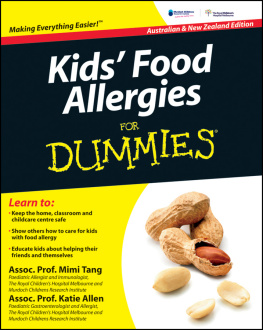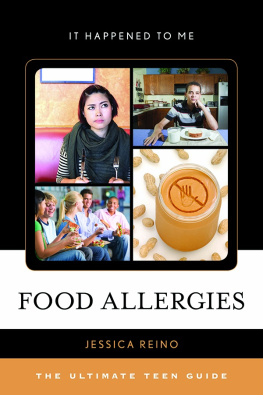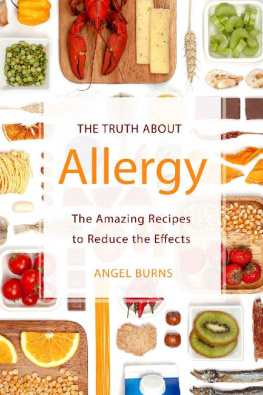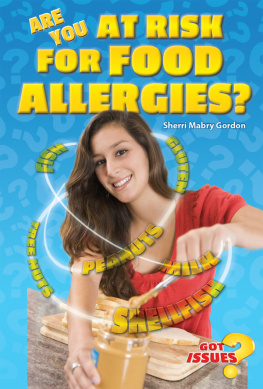Another Persons Poison
ARTS AND TRADITIONS OF THE TABLE
PERSPECTIVES ON CULINARY HISTORY
ARTS AND TRADITIONS OF THE TABLE: PERSPECTIVES ON CULINARY HISTORY
ALBERT SONNENFELD, SERIES EDITOR
For the list of titles in this series, see .
Another Persons Poison
A HISTORY OF FOOD ALLERGY
Matthew Smith
COLUMBIA UNIVERSITY PRESS NEW YORK
COLUMBIA UNIVERSITY PRESS
Publishers Since 1893
New York Chichester, West Sussex
cup.columbia.edu
Copyright 2015 Columbia University Press
All rights reserved
E-ISBN 978-0-231-53919-7
Library of Congress Cataloging-in-Publication Data
Smith, Matthew, 1973
Another persons poison : a history of food allergy / Matthew Smith.
pages cm. (Arts and traditions of the table: perspectives on culinary history)
Includes bibliographical references and index.
ISBN 978-0-231-16484-9 (cloth : alk. paper)
ISBN 978-0-231-53919-7 (e-book)
1. Food allergyHistory. I. Title.
RC596.S39 2015
616.975dc23
2014041702
A Columbia University Press E-book.
CUP would be pleased to hear about your reading experience with this e-book at .
COVER IMAGE: PEANUT, WHEAT(SHUTTERSTOCK; TEST TUBESGETTY/PAUL TILLINGHAST)
COVER DESIGN: MARY ANN SMITH; BOOK DESIGN: VIN DANG
References to Web sites (URLs) were accurate at the time of writing.
Neither the author nor Columbia University Press is responsible for URLs
that may have expired or changed since the manuscript was prepared.
FOR MICHELLE,
whose enduring selflessness reveals the true shape of love
Contents
WHEN I BEGAN MY DOCTORAL RESEARCH at the University of Exeter, my supervisor, Mark Jackson, would introduce me as follows: This is Matt Smith. Hes doing a PhD on allergy. At the time, this slightly befuddled me since I thought I was working on ADHD. Ultimately, both of us were correct, but, while writing this book, I have grown increasingly grateful to Mark not only for his peerless supervision but also for steering me toward the fascinating world of allergy. I am very grateful that Jennifer Crewe and Columbia University Press were willing to take this project on board and thank them, as well as the reviewers, for their suggestions.
This book would not have been possible without the generous support of the Wellcome Trust. In addition to a Wellcome Trust postdoctoral fellowship, which allowed me to research and write, the Wellcome Library and its fabulous staff (particularly Ross MacFarlane and Phoebe Harkins) always went beyond the call of duty. I also relied on the Royal Society of Medicines Library, Harvard Universitys Francis A. Countway Library, Boston Universitys Howard Gotlieb Archival Research Center, and, especially, the AAAAI and ACAAI records at the University of WisconsinMilwaukee and the University of WisconsinParkside, respectively. I am also grateful to the BBC/AHRC New Generation Thinker scheme for allowing me to reach out to a wider audience.
Although oral history does not feature heavily in this book, I did conduct some interviews and I want to thank my interviewees. I had always thought that there are those who eat to live and those who live to eat; you helped me realize that reality is much more complicated. Your stories informed my approach as much as anything, and I will make more explicit use of them in future. Thanks also to Anne Muoz-Furlong and FARE for connecting me with interviewees.
I am also grateful for my colleagues at the University of Strathclyde and the Centre for the History of Health and Healthcare. Jim Mills and Arthur McIvor provided me with excellent advicein addition to weekly squash beatingsand Emma Newlands, John Stewart, Janet Greenlees, Peter Kirby, Vicky Long, and others offered guidance and support. Thanks also to Gayle Davis and the executive committee of the Society for the Social History of Medicine for reminding me that the history of medicine doesand always willhave a purpose in informing medical debate.
Friends and family have also kept me focused. Thanks especially to Stephen Mawdsley for sending me new stories about allergy, which would have passed me by, and Tindy Agaba for putting life in perspective. Mark Doidge, Angus Ferguson, Despo Kritsotaki, Matthew Eisler, Rima Apple, Ali Haggett, Leah Songhurst, Ed Ramsden, Jonathan Reinarz, David Gentilcore, Erika Dyck, and many others all provided advice and friendship along the way. Although I am grateful to all my family and friends back home in Canada for their encouragement (Mom, Dad, Herberts, Burkes, Lentzes, Burnses, Pattersons, all), I am eternally in debt to Michelle and Dashiell for their patience and understanding andlast but not leastlittle Solveigh, for waiting until the writing was done before making her arrival!
AAA | American Academy of Allergy |
AAAI | American Academy of Allergy and Immunology |
AAAAI | American Academy of Allergy, Asthma and Immunology |
AAEM | American Academy for Environmental Medicine |
AAO | American Academy of Otolaryngology |
ABAI | American Board of Allergy and Immunology |
ABMS | American Board of Medical Specialties |
AC | Anaphylaxis Campaign |
ACA | American College of Allergists |
ACAAI | American College of Allergy, Asthma and Immunology |
ACSH | American Council on Science and Health |
ADHD | attention deficit hyperactivity disorder |
AMA | American Medical Association |
APA | American Psychiatric Association |
BHA | butylated hydroxytoluene |
BHT | butylated hydroxyanisole |
BMJ | British Medical Journal |
CECU | Comprehensive Environmental Control Unit |
CMAJ | Canadian Medical Association Journal |
DSM | Diagnostic and Statistical Manual of Mental Disorders |
FAAN | Food Allergy and Anaphylaxis Network |
FAI | Food Allergy Initiative |
FAN | Food Allergy Network |
FARE | Food Allergy Research and Education |
FDA | Food and Drug Administration |
FPIES | food proteininduced enterocolitis syndrome |
FSA | Food Standards Agency |
HCFA | Health Care Financing Administration |
HiB | Haemoiphilus influenzae type b |
IFIC | International Food Information Council |
IgA | immunoglobulin A |
IgD | immunoglobulin D |
IgE | immunoglobulin E |









